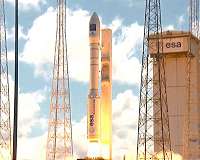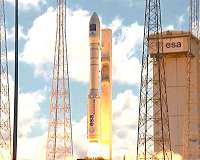
Preparations resume with 53 satellite passengers that are Little for Vega mission (Image Credit: SNN)
The launch effort has declared for Arianespace’s next mission, which is going to be the proof-of-concept flight with the Vega launcher’s”ride-share” configuration – called the Small Spacecraft Mission Service (SSMS).
Scheduled to this month’s middle by the Spaceport in French Guiana, it will attic 53 micro- and nanosatellites for 21 customers’ advantage, deploying these payloads.
For the mission, designated Flight VV16 in the launcher household numbering system of Arianespace, Vega will take seven microsatellites. To 150 kg., along with 46 smaller CubeSats. These spacecraft are to serve several applications, such as instruction, telecommunications, science, technology and Earth observation.
The maiden flight for Europe’s SSMS
The SSMS program, pioneered by the European Space Agency (ESA) with the European Commission’s participation, will improve Arianespace’s ability to provide ride-share solutions tailored to the flourishing small satellite marketplace.
The firm that is manufacturing contractor for Vega launch vehicles, avio , also developed the SSMS concept.
The SSMS dispenser consists of components which are constructed as needed to serve as the port with payloads composed of CubeSats and microsatellites. Capable of taking a selection of payload mixes, the SSMS configuration has been designed to be as responsive as possible in fulfilling the launch ceremony market’s needs for both clients.
Launch team members arrive from Europe
An operations to implement sanitary protective steps was performed on the Spaceport’s SLV launch pad throughout February, but followed in mid-March Meeting of Flight VV16 Vega launcher.
Together with the decision a group of some 70 people – led by engineers and engineers by Avio, also – has been hauled aboard a jetliner from Europe.
The group members underwent a quarantine period prior to being licensed to work at the launch website.
“Protective measures regarding COVID-19 have been accepted during the launch site’s facilities, and mission employees have received instructions on respecting the sanitary guidelines.”
Wilmart noted that among the activities was an assessment of using intelligent glasses during payload prep activities.
“The results are extremely favorable, and this effective way of being connected enables customers to monitor operations performed by Arianespace employees in their satellites.”
Nanosatellite with global mission analyzed for distance
Paris (ESA) May 29, 2020
ESA’s largest antenna test facility remains operational despite the COVID-19 pandemic, performing pre-flight testing for the latest satellite in a constellation to serve the net of things.
“The main change from a normal test effort is that contact between people is being minimised, to fulfil social distancing needs,” states antenna evaluation engineer Eric Van Der Houwen.
“So the clients arrived here to mount their nanosatellite inside the chamber, then hammered – normally they’d… read more
– Advertisement –









